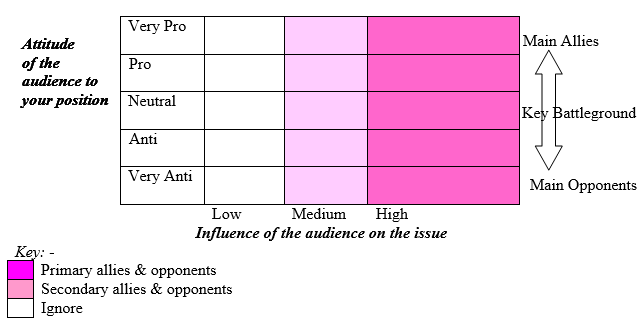
Category:
Recommended
Description and Purpose:
This tool is a matrix that can be used to categorize the allies and opponents of your advocacy issue. It helps to identify your main allies and opponents, and those whose neutral position make them targets.
Method:
Consider and categorize the allies and opponents of your advocacy issue using the following matrix. Write the name of the individual or name of the organization on a post it note and plot them on the chart according to your perception of their attitude towards and influence over the issue you intend to advocate on.
Opponents: Individuals or organizations who may oppose the advocacy campaign because they may be impacted negatively by the changes advocated, because of disagreement about underlying values or merely because they may lose face.
Allies: Beneficiaries, individuals or organizations who will directly benefit or who can be persuaded to support your advocacy effort because of sympathetic concerns and similar values.
Targets: Individuals or organizations that have the power to effect the policy change or change in implementation of a policy or practice that is outlined in your advocacy objective.
Use this sorting process as a vehicle for discussion. It is very possible that some individuals within the same organization may be allies and others may be neutral or opponents, and that their position may change over time (perhaps as a result of your advocacy!)You can use the matrix to discuss whether the assessment of main allies, targets, and opponents and neutral players is correct, and move your post it notes around accordingly. There may be factors that influence this analysis (e.g. reasons behind neutrality that would make it a waste of effort to try to influence).
Keep for consideration in the strategic planning process.
From the matrix, you can identify which of the following five influencing strategies may be most appropriate:
- Build alliances (with allies)
- Persuading the stakeholder that the issue is important (mainly for allies with high influence but low interest)
- Persuading the stakeholder that your position is right (mainly for influential neutrals, targets and soft opponents)
- Helping to increase the influence of the stakeholder (mainly for allies with low influence)
- Reducing the influence of the stakeholder (mainly for opponents with high influence)
You will need to prioritize the stakeholder groups you can target, and plan strategically according to available human and financial resources.



